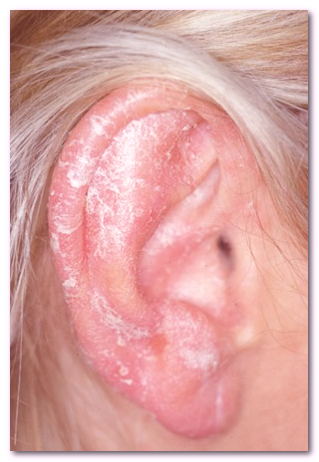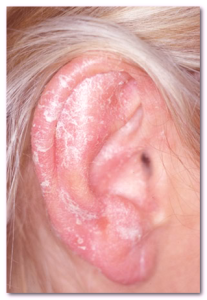Crusty ears is a symptom of some kind of skin rash or other underlying conditions that affect the ears, including the external and internal regions as well as the surrounding areas. Some of the common causes, symptoms, and treatment options for crusty ears are discussed below.
Symptoms accompanying crusty ears
Crusty ears caused due to ear rashes are often similar to skin rashes affecting other areas of the body. Some of the signs and symptoms that may accompany crusty ears are listed below:
- The affected skin on the ear may experience blistering, spots, grainy lumps, or tiny bumps development especially behind the ears. These skin rashes may occasionally be full of fluids, resulting in irritation, itchiness, and pain.
- Pimple-like growths may also develop. Such growths may multiply over time.
- There may be swelling or inflammation of the rash. The skin behind the ears may become reddish or pinkish in color.
- When crusty ears is accompanied by vomiting, fever, etc. along with skin rashes, then it may be an indication of some underlying health disorder.
Causes of crusty ears
Some of the common causes and respective symptoms and treatments of crusty ears are listed below:
- Varied infections: Crusty ears may be caused due to bacterial, fungal, or viral infections of the skin on the ears. For example, improperly done ear piercings are at increased risk to developing bacterial infections. Patients with ear infections may experience itchiness, redness, and skin scaling. Bacterial and fungal infections are respectively treated with topical and/or oral antibiotics or antifungals. Maintaining good hygiene is also recommended.
- Dermatitis: Contact or atopic dermatitis are often caused due to irritation or an allergic reaction to some chemicals. Patients may experience inflammation, itchiness, and redness. Crusty ears caused by dermatitis are treated with topical or oral drugs, antibiotics, and/or phototherapy. Home treatments include avoidance of harsh soaps, moisturizing the skin on a daily basis, wearing clothes that are light and made of soft fabrics, use of humidifiers, and using ice packs.
- Seborrheic dermatitis: This dermatological condition causes dandruff-like white skin flaking and scaling. Along with crusty ears, especially on the back part of ear or ear creases, patients may experience itchiness, dry skin, and discomfort, etc. The exact cause of seborrheic dermatitis is not clear, but certain factors like stress, cold weather, malassezia yeast infection, Parkinson’s disease, and/or HIV/AIDS can trigger or aggravate it. The condition is treatable but cannot be cured. Hence, patients tend to experience flare-ups at regular intervals. Treatment involves daily, careful, and through washing of the affected section of ear skin with medicated shampoos and soaps.
- Eczema: It is a persistent skin disorder marked by rashes, redness, itching, and inflammation of skin. Doctors treat it with lifestyle changes and topical and oral medications.
- Heat rash: This skin condition is caused due to blockage of sweat glands which causes moisture and sweat to get trapped under the skin. Patients may experience the formation of tiny bumps on skin, itchy and crusty ears, flaking skin, and redness. Keeping the skin dry is the best treatment option. Use prickly heat powders, keep the skin moisturized and hydrated, use humidifiers, and follow other guidelines to prevent excessive sweating and exposure to heat. Severe heat rashes are treated with medications.
- Psoriasis: This skin disorder is marked by irritation, itchiness, redness, abnormal patchy and flaking skin, and development of scaly white areas on the skin. Treatment is focused on containing the rash and preventing infections. Topical and oral medications may be prescribed along with injections. Phototherapy may also be used in certain cases.
- Measles: This viral infection is another cause of crusty ears. Patients may develop a fever along with skin rashes on the forehead and behind the ears; the rash occurs as patches of small, pinkish, flat spots. Medications are used for alleviation of pain and fever. Ear infections are treated with antibiotics. Home remedies include keeping hydrated, salt water gargling, sufficient rest, and cold compresses.
- Bacterial meningitis: It is a serious condition that requires urgent medical care. One of the most common symptoms is the development of a purplish to reddish rash. Late treatment can increase the risk to development of life-threatening complications. The condition is treated with antibiotics, painkillers, and sedatives. Vaccines are the best way to prevent/avoid this cause of crusty ears.
- Chickenpox: This contagious disease is marked by formation of itching distinctive blisters or sores that initially develop on the face, along with cough, fever, and headaches. The infection is treated with antivirals and topical medications. Home remedies include increased intake of fluids, not scratching the blisters, maintenance of good hygiene, and use of anti-itch creams, etc. Vaccination is the best way to prevent crusty ears-causing chickenpox.
- Folliculitis: It is infection of the hair follicles and is characterized by itching skin rashes, irritation, redness, and blister formation. As per the seriousness of the infection, crusty ears caused by folliculitis may be treated in varied ways including use of antifungals or antibiotics.
- Middle ear infection: Also called chronic otitis media, it is caused due to viral or bacterial infection and multiplication of the fluid that accumulates in the middle ear. Along with crusty ears and skin rash, patients may experience chills, fever, pus drainage, and ear fullness and pain. Treatment is dependent on the symptoms and its severity. Oral antibiotics may be prescribed for fever and pain alleviation. Excess fluids may need to be drained via surgery. Sufficient hydration and rest can help the overall healing and recovery process.
- Dry skin: Loss of moisture from skin can cause crusty ears, itchiness, and scaling. Dryness of the skin on the ears may occur due to varied underlying conditions. Treatment of dry skin is dependent on diagnosis of the underlying caused. Intake or water and fluids, moisturizing the skin, and use of OTC lotions and creams is suggested for alleviation of dry skin.
- Otis Externa: Also called ‘swimmers ear,’ the condition is marked by inflammation of the outer ear and the ear canal. Patients may develop a skin rash at the back part of the ear, crusty ears, and itchiness. It is treated with antifungal medications, antibiotics, ear drops, and hot compresses, etc.


Где Вы ищите свежие новости?
Лично я читаю и доверяю газете https://www.ukr.net/.
Это единственный источник свежих и независимых новостей.
Рекомендую и Вам